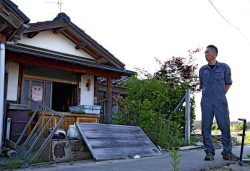11 Months After Noto Peninsula Earthquake, Couple Decides to Place Daughter’s Ashes in Grave; Maki-e Artist Remembered by Family Every Day

Tomio Shimada holds a sake cup, the last maki-e lacquerware work completed by his daughter Reina, in Sanda, Hyogo Prefecture, on Nov. 23.
21:00 JST, December 14, 2024
KANAZAWA — A couple from Sanda, Hyogo Prefecture, whose daughter died in the Wajima Morning Market fire caused by the Noto Peninsula Earthquake almost one year ago has decided to place the urn containing her ashes in her grave ahead of the first anniversary of her death.
Tomio Shimada, 73, and his wife Yuko, 66, had kept their daughter Reina’s remains with them, as they still could not accept her death. Hoping that “many people will be able to meet Reina,” who died at the age of 36, they made the decision to place her ashes in the grave.
Reina was a Wajima maki-e artisan whose home and workshop were in the Asaichi-dori area where the Wajima Morning Market was held. Maki-e is a decorative lacquerware technique that uses golden, silver and other colored powder.
“I wish I could have seen more of Reina’s work,” Tomio said recently, holding Reina’s last work: a sake cup with a design of a cat looking at a goldfish bowl.
Reina normally went back to her hometown during the New Year holiday period, but she told her parents she would be too busy to visit this year.
A little after noon on Jan. 1, Reina sent pictures in a Line group chat of the New Year’s dishes she had made, including kurikinton chestnut sweets and namasu, along with a message saying, “I worked hard on the presentation.”
Four hours later, the earthquake struck. Reina’s parents tried to reach her, but her phone went unanswered and Line messages were left unread. They tried to convince themselves she was taking refuge somewhere or was in hospital somewhere with amnesia. However, on Jan. 10, the police informed her that human bones had been discovered in the ruins of her home.
Reina’s parents were able to go to Wajima three days later. The area where Reina lived had been turned into charred ruins. In February, DNA analysis confirmed that the discovered remains were hers.

Reina Shimada
According to her parents, Reina liked drawing, and from a young age she often drew pictures of animals and anime characters. She started taking art classes in junior high school and made sure to select a high school with an art department.
“She loved school. She even went there on Saturdays and Sundays to do things like draw and participate in student council activities,” Yuko recalled.
Reina learned about maki-e at high school. She soon took up the craft and went on to study maki-e at a junior college in Akita City.
From 2008, she honed her skills at the Ishikawa Prefectural Wajima Institute of Lacquer Arts in Wajima. After graduating, she apprenticed with a maki-e artist. While working part-time to earn a living, she threw herself into the craft.
She became independent in 2018, receiving so many maki-e orders that she could support herself without any money sent from her parents.
Most of Reina’s works were destroyed in the fire, but about 100 pieces that had already been delivered to customers are intact. Thanks to the generosity of her business partners, several have been sent to her parents, who have learned about the popularity of her unusual style.
Reina’s family remembers her every day. They will never forget the family trip they took with her to Kyoto and her smiling face whenever she was at home.
Her parents decided to have their daughter’s ashes placed in a grave near the family home, hoping that her friends from elementary, junior high and high school as well as college would come to visit her.
“I often think, ‘She should still be at home,’ but I bet her friends also want to see her.” Yuko said with a sad smile.
"Society" POPULAR ARTICLE
-

M4.9 Earthquake Hits Tokyo, Neighboring Prefectures
-

M7.5 Earthquake Hits Northern Japan; Tsunami Waves Observed in Hokkaido, Aomori and Iwate Prefectures
-

Israeli Tourists Refused Accommodation at Hotel in Japan’s Nagano Pref., Prompting Protest by Israeli Embassy and Probe by Prefecture
-

Tsukiji Market Urges Tourists to Avoid Visiting in Year-End
-

M5.7 Earthquake Hits Japan’s Kumamoto Pref., Measuring Upper 5 Intensity, No Tsunami Expected
JN ACCESS RANKING
-

Keidanren Chairman Yoshinobu Tsutsui Visits Kashiwazaki-Kariwa Nuclear Power Plant; Inspects New Emergency Safety System
-

Imports of Rare Earths from China Facing Delays, May Be Caused by Deterioration of Japan-China Relations
-

University of Tokyo Professor Discusses Japanese Economic Security in Interview Ahead of Forum
-

Japan Pulls out of Vietnam Nuclear Project, Complicating Hanoi’s Power Plans
-

Govt Aims to Expand NISA Program Lineup, Abolish Age Restriction






















